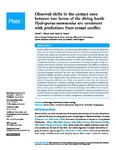Observed shifts in the contact zone between two forms of the diving beetle Hydroporus memnonius are consistent with predictions from sexual conflict.
| dc.contributor.author | Bilton, David | |
| dc.contributor.author | Foster, GN | |
| dc.date.accessioned | 2016-06-22T14:50:06Z | |
| dc.date.available | 2016-06-22T14:50:06Z | |
| dc.date.issued | 2016-06-14 | |
| dc.identifier.issn | 2167-8359 | |
| dc.identifier.issn | 2167-8359 | |
| dc.identifier.other | e2089 | |
| dc.identifier.uri | http://hdl.handle.net/10026.1/4935 | |
| dc.description.abstract |
Sexual conflict drives both inter- and intrasexual dimorphisms in many diving beetles, where male persistence and female resistance traits co-evolve in an antagonistic manner. To date most studies have focussed on species where rough and smooth females and their associated males typically co-occur within populations, where phenotype matching between morphs may maintain forms as stable polymorphisms. The Palaearctic diving beetle Hydroporus memnonius is characterised by having dimorphic (rough var. castaneus and smooth, shining) females and associated males which differ in persistence traits; the two forms being largely distributed parapatrically. In this species, instead of mating trade-offs between morphs, males associated with castaneus females should have a mating advantage with both this form and shining females, due to their increased persistence abilities on either cuticular surface. This may be expected to lead to the replacement of the shining form with castaneus in areas where the two come into contact. Using data collected over a thirty year period, we show that this process of population replacement is indeed occurring, castaneus having expanded significantly at the expense of the shining female form. Whilst populations of both forms close to the contact zone appear to differ in their thermal physiology, these differences are minor and suggest that the expansion of castaneus is not linked to climatic warming in recent decades. Instead we argue that the observed spread of castaneus and its associated male may result from the dynamics of sexually antagonistic coevolution in this beetle. | |
| dc.format.extent | e2089-e2089 | |
| dc.format.medium | Electronic-eCollection | |
| dc.language | en | |
| dc.language.iso | en | |
| dc.publisher | PeerJ | |
| dc.subject | Biogeography | |
| dc.subject | Dytiscidae | |
| dc.subject | Intrasexual dimorphism | |
| dc.subject | Population | |
| dc.subject | Sexual conflict | |
| dc.title | Observed shifts in the contact zone between two forms of the diving beetle Hydroporus memnonius are consistent with predictions from sexual conflict. | |
| dc.type | journal-article | |
| dc.type | Journal Article | |
| plymouth.author-url | http://www.ncbi.nlm.nih.gov/pubmed/27326372 | |
| plymouth.issue | 6 | |
| plymouth.volume | 4 | |
| plymouth.publication-status | Published | |
| plymouth.journal | PeerJ | |
| dc.identifier.doi | 10.7717/peerj.2089 | |
| plymouth.organisational-group | /Plymouth | |
| plymouth.organisational-group | /Plymouth/Faculty of Science and Engineering | |
| plymouth.organisational-group | /Plymouth/Faculty of Science and Engineering/School of Biological and Marine Sciences | |
| plymouth.organisational-group | /Plymouth/REF 2021 Researchers by UoA | |
| plymouth.organisational-group | /Plymouth/REF 2021 Researchers by UoA/UoA07 Earth Systems and Environmental Sciences | |
| plymouth.organisational-group | /Plymouth/Research Groups | |
| plymouth.organisational-group | /Plymouth/Research Groups/Marine Institute | |
| plymouth.organisational-group | /Plymouth/Users by role | |
| plymouth.organisational-group | /Plymouth/Users by role/Academics | |
| dc.publisher.place | United States | |
| dcterms.dateAccepted | 2016-05-07 | |
| dc.identifier.eissn | 2167-8359 | |
| dc.rights.embargoperiod | No embargo | |
| rioxxterms.versionofrecord | 10.7717/peerj.2089 | |
| rioxxterms.licenseref.uri | http://www.rioxx.net/licenses/all-rights-reserved | |
| rioxxterms.licenseref.startdate | 2016-06-14 | |
| rioxxterms.type | Journal Article/Review | |
| plymouth.oa-location | https://peerj.com/articles/2089/ |


